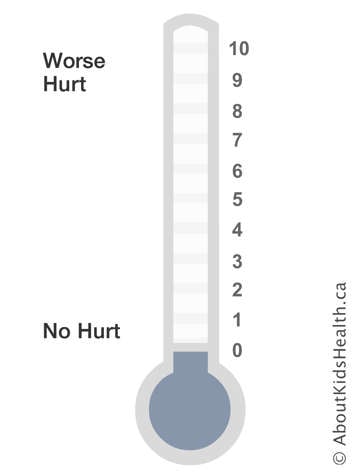Helping your child manage their pain at the hospital
Most children in hospital have pain. All children should know that pain goes away and that many kids have pain just as they do.
You and your child will work together with the health-care team to manage pain. Feel free to ask questions and talk about your child's pain with the team.
Medication is not the only way to relieve pain. Other ways to manage pain are described here. The following information will also help you learn ways to talk about pain.
Ways to measure pain
"How does it feel?" "How much does it hurt?" "Where does it hurt?"
These are some of the questions staff at the hospital may ask to learn more about your child's pain.
It is important for your child to be able to talk to you or a member of their health-care team about their pain so it can be treated and your child will feel better. Your child knows their own pain best, so we need to find a way to help them describe it.
The tools most often used to measure a child's pain are a faces scale or a number scale.
The faces scale is used with younger children who understand pictures better than numbers.

The Number Scale
The number scale is used with children who are school-age and older because they understand numbers and their values.

Creating your own scale
If these scales do not work well for your child, pick a theme that they enjoy or can relate to such as colours, animals or shapes. Have your child choose the item that describes their kind of pain.
Other signs your child is in pain
Sometimes children cannot use a scale to rate their pain. Here are some other signs that you can look for to tell if your child is in pain:
- not playing
- being more quiet than usual
- going back to using younger behaviours such as thumb-sucking or wetting the bed
Coping with pain
After you find out how much pain your child is feeling, you can work at finding different strategies to manage that pain. There are many ways to help a child cope with pain. Together with your child, read the coping strategies below. Whenever you can, have your child decide which coping strategy would work best for them.
Breathing
Deep breathing helps manage pain by relaxing your body. This works best when you breathe slowly in through your nose and out through your mouth. Try to make each breath last for the count of five. You can use your imagination by picturing blowing out all the candles on your birthday cake or blowing up a balloon. Another fun and handy tool to help with deep breathing is to blow bubbles.
Imagination
Using your imagination reduces anxiety and pain and will make you feel more calm and relaxed. Make up a story together, talk about your favourite place or thing, or remember and discuss a special time in your life.
This strategy is best used with school-aged children six to 12 years old.
Relaxation
Relaxation is good for pain that does not seem to want to go away. Find a comfortable position with your arms and legs outstretched. Starting at your head, think about each body part all the way until you get to your toes. Imagine your body getting heavier and heavier until it is hard to lift any part of your body. This works best when you keep your breaths long, deep and slow. Take your time and stay relaxed.
This strategy is ideal for pre-teens and teens.
Distraction
Distraction is a good way to focus attention away from pain and onto something familiar, safe and enjoyable. Choose an activity such as reading, arts and crafts, puzzles, board games, movies or video games.
Redirection
Redirection helps you think more positively about your body and how it feels. Which parts of your body does not hurt? Try to think about that.
Child life specialists know many more tricks and techniques to help children manage their pain. If you would like to learn more, please talk to the child life specialist for your program.
Tools
Distraction tools are known to help children manage their pain. These are items that can be used during potentially painful or stressful situations or to manage ongoing pain. You know your child best, so together with your child, decide which of the following distraction items they would like to try:
- magic wands
- bubbles
- light-up toys
- singing
- music
- a favourite object, such as a stuffed animal
- picture books
- videos
- joke books
- squishy balls
- playdough
- pinwheels
- search and find books
- word and name games
Resources
Child life specialists find the following books to be helpful:
- A Child in Pain: How to Help, What to Do by Leora Kuttner
- Pain, Pain, Go Away: Helping Children with Pain by Patrick J. McGrath, G. Allen Finley, and Judith Ritchie
- Keys to Parenting your Anxious Child by Katharina Manassis
This website has great information for children and families about managing pain:
